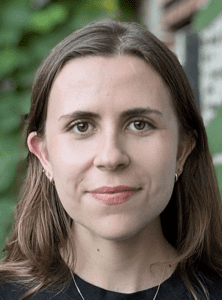Posted By: HGG Advances
Each month, the editors of Human Genetics and Genomics Advances interview an early-career researcher who has published work in the journal. This month we check in with Sophia Gunn (@sophie_gunn32) to discuss her paper “Comparison of methods for building polygenic scores for diverse populations.”
HGGA: What motivated you to start working on this project?

SG: There has been a lot of work in recent years on developing polygenic scores (PGS) for multi-ancestry populations, but most studies have focused on populations genetically similar to European and East Asian reference groups. In this project, we utilize data from both the Million Veterans Program (MVP) and All of Us Research Program (AoU) which are both incredible resources for studying diverse populations. Their cohorts were designed to represent people in the United States and consist of large sample sizes of individuals genetically similar to African, American and European reference groups. When I realized I could leverage the MVP’s gwPheWAS results–a large-scale effort to generate ancestry-specific and multi-ancestry GWAS for 2,068 traits derived from VA EHR data–to build PGS and evaluate them in the AoU data, I jumped at the opportunity.
HGGA: What about this paper/project most excites you?
SG: When I first began working on the topic of PGS for multi-ancestry populations we knew that PGS did not transfer well across groups, and it seemed entirely possible that maybe this was because of population-specific effects or environmental interactions and to properly model genetic risk we would need population-specific scores. The fact that our results show that the multi-ancestry scores perform consistently well, and for most traits best, in all three populations in AoU demonstrates that this is likely not the case. While we still have a lot of work to do to ensure PGS perform as well in underrepresented populations in genetic research as they do in populations genetically similar to European reference groups, I am optimistic that we will eventually be able to develop a single score to model genetic risk, regardless of an individual’s genetically inferred ancestry.
HGGA: What do you hope is the impact of this work for the human genetics community?
SG: In this study we conclude that PGS built with the multi-ancestry PGS method PRS-CSx perform better than scores developed with other methods, and that PGS generated with multi-ancestry meta GWAS are more predictive than single-ancestry PGS in underrepresented populations. I hope researchers will be able to reference our results when deciding how to build PGS of their own, and that our results will motivate researchers to build multi-ancestry PGS when they can. We have also made the PGS we built for this study available to all on the PGS catalog. Finally, in this work we demonstrate how to utilize our R package ‘coranova’ to formally compare PGS performance in multiple populations. Hopefully, others will see the benefit of such a package and try it out themselves.
HGGA: What are some of the biggest challenges you’ve faced as a young scientist?
SG: As a young scientist, my biggest challenge right now is deciding which research questions to pursue as I build my academic career. For my postdoc I’ve joined a group studying psychiatric disorders, and I’m hoping to engage more with the specific biology of the traits we study and let that motivate our analysis and method development. It’s very exciting; there is so much interesting work happening right now in human genetics, but it’s also overwhelming. I know to do good work I will need to focus my energy on a few questions I can answer well.
HGGA: And for fun, what is one of the most fascinating things in genetics you’ve learned about in the past year or so?
SG: I recently attended the Advances in Precision Medicine: Frontiers in Human Genetics Conference at Columbia University and heard Nasa Sinnott-Armstrong speak about their work on environmental patterns in biomarker data in the UK Biobank. They had a really nice finding that pinpointed variants associated with timing of glucose measures throughout the day. I thought it was a clever idea that took full advantage of the richness of EHR data available to scientists nowadays and their results have a direct biological interpretation, which doesn’t always happen in GWAS!
Sophia Gunn, PhD is a postdoctoral fellow at the New York Genome Cener.
